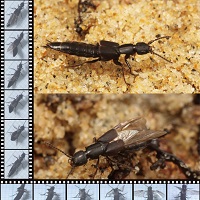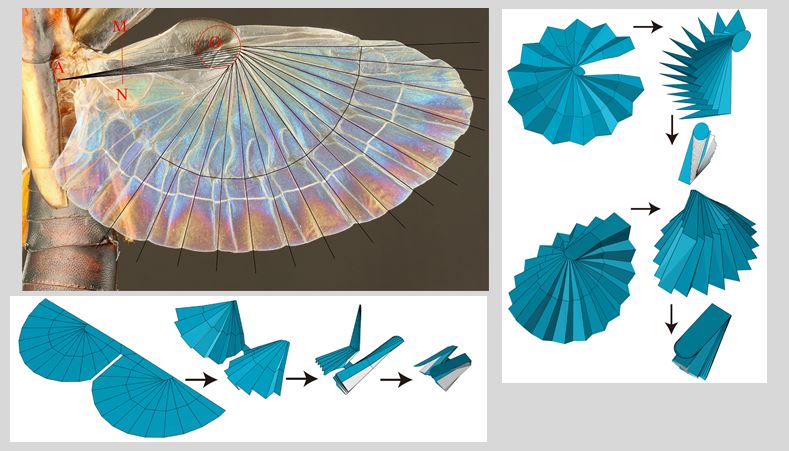When studying bird wings, it seems that they unfold their wings during flight and fold them into the body when not flying. The folded structure, which unfolds only when in use and folds them otherwise, seems to be efficient in terms of both space efficiency and protection. Folded structures are also seen in other areas, such as in the intestinal wall, to increase the surface area, and in proteins that function by adopting a three-dimensional structure.
For storage and protection
Besides bird wings, the wings of beetles such as rhinoceros beetles also seem to be folded, and when not in use, the hind wings for flight are covered by the hard front wings, so I feel that they have a stronger image of being stored and protected than bird wings. The folding structure of insect wings to achieve this folding seems to be complex and requires highly advanced ingenuity. In particular, a type of insect called rove beetle is characterized by an asymmetrical folding pattern and the fact that one wing can be folded in two folding patterns, and is said to be the most evolved folding pattern.

Also, earwigs’ wings can be folded into the most compact shape of any insect, with a fold ratio of 1:15, and a special spring mechanism has been discovered that allows them to maintain their spread-out shape. The structure and functionality of insects is amazing.

In addition, DNA, which stores the genetic information of living organisms, is wound around proteins called histones to form a structure called a nucleosome, which is then folded to fit 2m of DNA into each cell. The folding of DNA also seems to serve the purpose of protection against damage in addition to storage.
to increase surface area
The internal folding structures, such as the pleated and bent structures seen in the intestinal wall, appear to be a device to maximize the surface area that comes into contact with substances. The intestinal wall increases the area that comes into contact with nutrients in order to absorb them, the inner membrane of mitochondria increases the area where the production parts and enzymes are located to produce ATP, and the thylakoid membrane of chloroplasts increases the area where photosynthetic pigments capture light. The increase in surface area is a device to save space and improve production efficiency.
To obtain a three-dimensional structure
Proteins are formed by a series of amino acids, which then fold to form a three-dimensional structure called folding, and their function is determined by that structure. It is apparently quite difficult to predict a three-dimensional structure from a linear molecular structure. Proteins can only function when they are folded, and when exposed to high temperatures such as heat, the folded structure becomes linear and they lose their function. It seems that sophisticated three-dimensional puzzles are constantly being created within living organisms.
As a way of growth
Many plant buds and other leaves unfold from a folded state called a folded leaf, and the folded structure seems to be used when growing while protecting important points. When flowers bloom, the folded state called a bud is also often seen. We don’t see many flowers in which the cells extend into the shape of a flower, so it seems that cells increase inside the bud, a folded flower is formed, and then the flower blooms. Although it has a protective role, the phenomenon of blooming all at once may also be due to the folding structure.
The folding structure is amazing
In addition, the membranes and skin of octopuses also fold to deform and store, and the necks and legs of turtles also fold and store in their shells. From microscopic folding to the folding of wings of living creatures, the functional structure of folding is amazing. The biological structure of the Earth is amazing.


